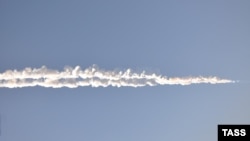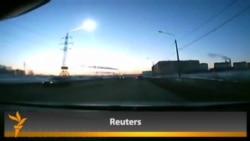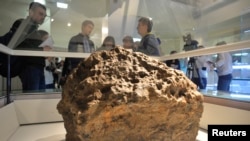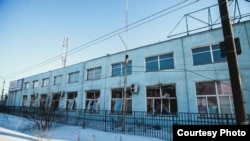Scientists have been studying data on the meteor that exploded over Chelyabinsk, Russia in February – the largest asteroid in more than a century to enter the earth’s atmosphere. Three studies published this week suggest that such occurrences could be more frequent in the future.
Why is the Chelyabinsk meteor now considered to be such a historic event?
The Chelyabinsk meteor is the largest known natural object to enter Earth’s atmosphere since an object widely suspected to be an asteroid caused a powerful explosion in the sky over the Podkamennaya Tunguska River in Siberia in 1908. It also is the only meteor to have caused so many injuries – with more than 1,200 people receiving medical attention. Most injuries were caused by falling debris and broken glass when the shockwave from the meteor left a trail of damage more than 180 kilometers wide.
NASA researcher Peter Jenniskens, who worked with Olga Popova from the Russian Academy of Sciences on a newly published study in the journal "Science," told the magazine "Scientific American" that Chelyabinsk is now "the gold standard" and "calibration point" for future studies on meteor and asteroid strikes.
What is its significance for scientists?
A meteor striking the earth had never before been documented by so much modern technology. This included seismic data, satellite photography, and, critically, so much camera footage from the ground.
WATCH: Video Footage Of The Meteor Impact And Aftermath
An image of the meteor was taken shortly after it entered the atmosphere by a European weather satellite. Satellite photographs taken a day after impact also helped researchers map out the spread of debris.
Most importantly, there were more than 400 videos posted online by witnesses. Many were from dashboard cameras of Russian drivers who recorded the initial explosion and the trajectory of debris entering Earth’s atmosphere.
There also were many witnesses for scientists to interview. They reported feeling intense heat from the initial fireball and, later, a gunpowder-like smell in the air.
Some of the injuries people suffered also provided lessons for researchers – like the flash sunburns from ultraviolet light emitted when the meteor exploded 30 kilometers over the ground.
Researchers also were able to collect and study fragments recovered from the area, including a 654-kilogram chunk recovered in October from the bottom of Chebarkul Lake.
What conclusions have scientists been able to make from the vast amount of data on the Chelyabinsk meteor?
A wealth of information has allowed scientists to determine that the Chelyabinsk meteor exploded in the sky with the energy of 500 kilotons of TNT – about the same force of a nuclear bomb – and a flash of light 30 times brighter than the sun.
But it also didn’t do as much damage as scientific models would have predicted for such an explosion.
Researcher Peter Brown, who worked on a new study published in the journal "Nature," said that probably is because of the meteor's speed and fairly shallow angle of trajectory.
Researchers are now reexamining how they will estimate the potential damage of future meteor strikes. They say the Chelyabinsk meteor will help them more accurately predict which asteroids will be the most dangerous to humanity in the future and to predict their impact.
A newly published study led by Jiri Borovicka from the Academy of Sciences in the Czech Republic concludes from trajectory data that the Chelyabinsk meteor probably had once been part of a larger two-kilometer-wide asteroid that scientists were tracking in February as it passed close to Earth.
The fact that the 19-meter-wide Chelyabinsk meteor was not detected until its impact and breakup in the Earth's atmosphere has raised concerns about the threat other small objects in space could pose for humanity. It also has led scientists to the conclusion that major meteor strikes probably occur more frequently on Earth than previously assumed.
Qing-Zhu Yin, a professor of Earth and planetary sciences at the University of California-Davis, who also worked on Popova's research team, told Reuters that the Chelyabinsk meteor was "a wake-up call" that must be studied in further detail to prevent humanity from going the way of the dinosaurs.
Why is the Chelyabinsk meteor now considered to be such a historic event?
The Chelyabinsk meteor is the largest known natural object to enter Earth’s atmosphere since an object widely suspected to be an asteroid caused a powerful explosion in the sky over the Podkamennaya Tunguska River in Siberia in 1908. It also is the only meteor to have caused so many injuries – with more than 1,200 people receiving medical attention. Most injuries were caused by falling debris and broken glass when the shockwave from the meteor left a trail of damage more than 180 kilometers wide.
NASA researcher Peter Jenniskens, who worked with Olga Popova from the Russian Academy of Sciences on a newly published study in the journal "Science," told the magazine "Scientific American" that Chelyabinsk is now "the gold standard" and "calibration point" for future studies on meteor and asteroid strikes.
What is its significance for scientists?
A meteor striking the earth had never before been documented by so much modern technology. This included seismic data, satellite photography, and, critically, so much camera footage from the ground.
WATCH: Video Footage Of The Meteor Impact And Aftermath
An image of the meteor was taken shortly after it entered the atmosphere by a European weather satellite. Satellite photographs taken a day after impact also helped researchers map out the spread of debris.
Most importantly, there were more than 400 videos posted online by witnesses. Many were from dashboard cameras of Russian drivers who recorded the initial explosion and the trajectory of debris entering Earth’s atmosphere.
There also were many witnesses for scientists to interview. They reported feeling intense heat from the initial fireball and, later, a gunpowder-like smell in the air.
Some of the injuries people suffered also provided lessons for researchers – like the flash sunburns from ultraviolet light emitted when the meteor exploded 30 kilometers over the ground.
Researchers also were able to collect and study fragments recovered from the area, including a 654-kilogram chunk recovered in October from the bottom of Chebarkul Lake.
What conclusions have scientists been able to make from the vast amount of data on the Chelyabinsk meteor?
A wealth of information has allowed scientists to determine that the Chelyabinsk meteor exploded in the sky with the energy of 500 kilotons of TNT – about the same force of a nuclear bomb – and a flash of light 30 times brighter than the sun.
But it also didn’t do as much damage as scientific models would have predicted for such an explosion.
Researcher Peter Brown, who worked on a new study published in the journal "Nature," said that probably is because of the meteor's speed and fairly shallow angle of trajectory.
Researchers are now reexamining how they will estimate the potential damage of future meteor strikes. They say the Chelyabinsk meteor will help them more accurately predict which asteroids will be the most dangerous to humanity in the future and to predict their impact.
A newly published study led by Jiri Borovicka from the Academy of Sciences in the Czech Republic concludes from trajectory data that the Chelyabinsk meteor probably had once been part of a larger two-kilometer-wide asteroid that scientists were tracking in February as it passed close to Earth.
The fact that the 19-meter-wide Chelyabinsk meteor was not detected until its impact and breakup in the Earth's atmosphere has raised concerns about the threat other small objects in space could pose for humanity. It also has led scientists to the conclusion that major meteor strikes probably occur more frequently on Earth than previously assumed.
Qing-Zhu Yin, a professor of Earth and planetary sciences at the University of California-Davis, who also worked on Popova's research team, told Reuters that the Chelyabinsk meteor was "a wake-up call" that must be studied in further detail to prevent humanity from going the way of the dinosaurs.

















